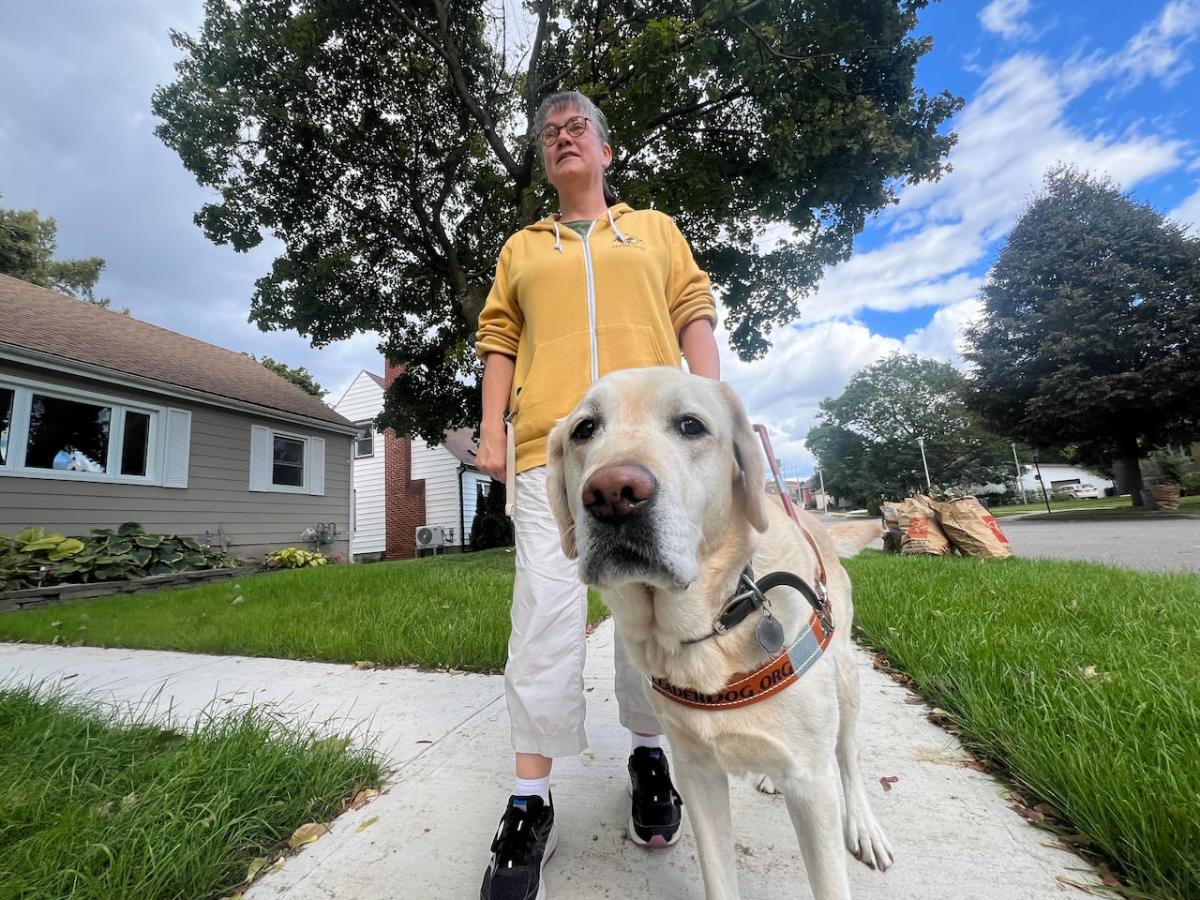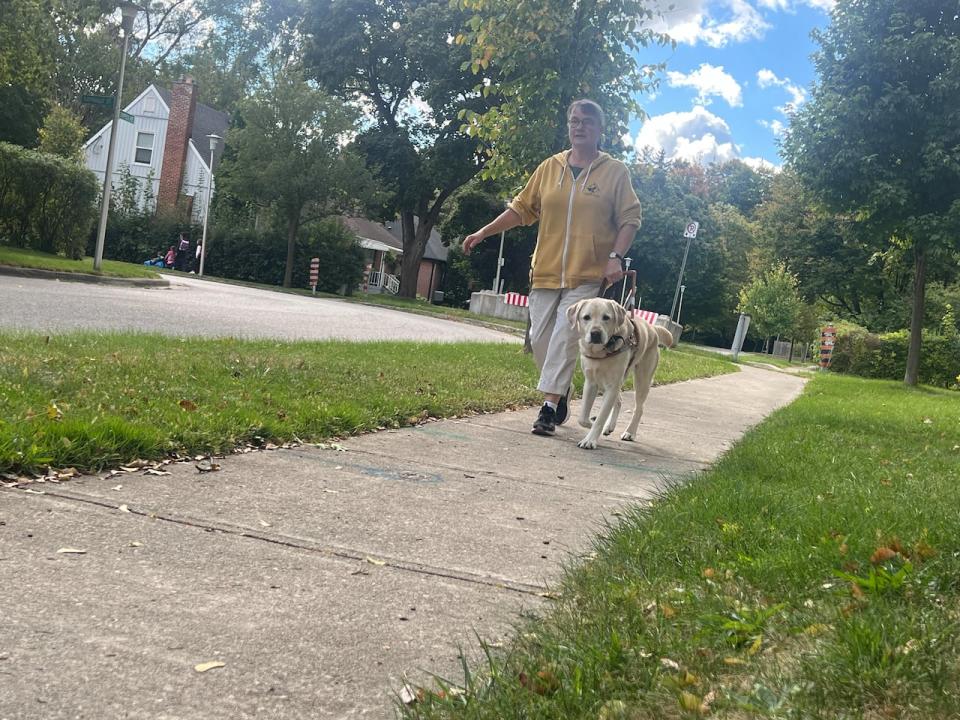


When Avril Rinn goes out for a walk, it’s her Labrador retriever Louie who leads the way.
Rinn, of London, Ont., is legally blind and Louie is her trusty guide dog, the second one she’s owned.
As he guides Rinn along the sidewalk, onto the bus or down the grocery store aisle, Louie doesn’t bark, beg or jump up on seats. He does his best to ignore other dogs because he’s focused and trained for the task at hand: Guiding Rinn around any dangers in her path.
And while Rinn loves Louie and his ability to allow her to move around in freedom and safety, she’s leaning toward not getting another guide dog after he’s gone. That’s because increasingly when she and Louie are in stores, restaurants and other indoor public spaces, Rinn is often not the only person with a dog, and lately she hasn’t been welcome with Louie.
“There’s an industry out there that provides very official looking service dog vests and even service dog ID cards,” said Rinn. “And people use them to get access to places.”
In addition to accredited guide dogs for the visually impaired, like Louie, there are other dogs that fall into the more general categories of “service dogs,” “support dogs” or “comfort dogs.”
These dogs help their owners cope in public with any number of challenges and disabilities, including non-apparent conditions such as autism, anxiety and post-traumatic stress disorder.
However, the difference between Louie and some of the service dogs Rinn encounters becomes apparent immediately.
“They really don’t have the right training or temperament to be in public,” she said. “They misbehave, they growl and their humans let them do things that a guide dog handler never world. It happens everywhere now.”

Avril Rinn, guided here by Louie, is legally blind. She’s rethinking whether it’s worth getting another guide dog after Louie, saying access to public spaces has become more difficult as more people bring service and comfort dogs into public spaces. (Andrew Lupton/CBC News)
Louie spent almost two years working with Leader Dogs for the Blind, a Michigan-based guide dog training program accredited by the International Guide Dog Federation. He was bred for the job and there was an extensive matching process before he was placed with Rinn.
In Canada, organizations such as the Canadian Institute for the Blind (CNIB) and the Lions Foundation of Canada Dog Guides have guide dog training programs with the same accreditation as the organization that trained Louie.
It’s a rigorous regime and many dogs don’t make the cut.
Rinn said service dogs who don’t behave well in public create challenges for owners with accredited service and guide dogs.
It’s a global concern. [People] experiencing difficulties encountering dogs that are not properly trained to be out in public as an assistance dog. – Chris Diefenthaler, Assistance Dogs International
Business owners are sometimes not sure about which dogs they should allow inside. Dogs who misbehave are sometimes lumped together with those who don’t, which can make business owners sceptical. It’s a situation Rinn and others say is leading to more limits to access public spaces.
“I am challenged far more today then I ever was in the past,” said Rinn.
Diane Bergeron is president of CNIB Guide Dogs, a charitable organization that trains accredited guide dogs in Canada. She’s also legally blind and has herself used a guide dog for 40 years.
‘It puts us at risk’ says guide dog owner
Bergeron said the current legislation allows almost anyone to claim their dog is a “service” or “comfort” dog but with no certification or training requirement.
“It gives a bad reputation to service dogs or guide dogs who meet the high standard,” she said.
Both Bergeron and Rinn have had other dogs approach theirs in public, distracting them from the main task of keeping their owners safe.
“It actually puts us at risk,” said Bergeron.
Both Bergeron and Rinn believe the number of people who bring dogs into public places has grown since the COVID-19 pandemic.
“It’s become a global concern,” said Chris Diefenthaler, executive director of Assistance Dogs International, a coalition of non-profit organizations that raise, train and place assistance dogs. “We’ve got member organizations around the world. They’re all reporting issues with their graduates that are experiencing difficulties with encountering dogs that are not properly trained to be out in public as an assistance dog.”
Diefenthaler said because it’s so difficult to craft legislation to suit every situation, the best solution is a reliance on behaviour standards. Also, business owners need to have a clear right to ask owners with disruptive dogs to leave or to deny them entry.
“If dogs are being disruptive out in public such as lunging, approaching people, interacting with other dogs, then they are truly not providing an assistance to the people they’ve been placed with,” she said. “Their owners may not realize the impact that they are having on the individual that has a trained assistance dog.”
Diefenthaler, Bergeron and Rinn all said they’re not out to deny access anyone to a dog that provides someone with comfort and help dealing with a condition, disability or injury. They just want people to know that when a dog misbehaves in public, it has the potential to reverse hard-won rights to allow visually impaired people access to public spaces.
“What I’d really like is more awareness,” said Rinn. “I would like people who are just bringing their dog with them for convenience or because they enjoy having it around to think twice about it.”